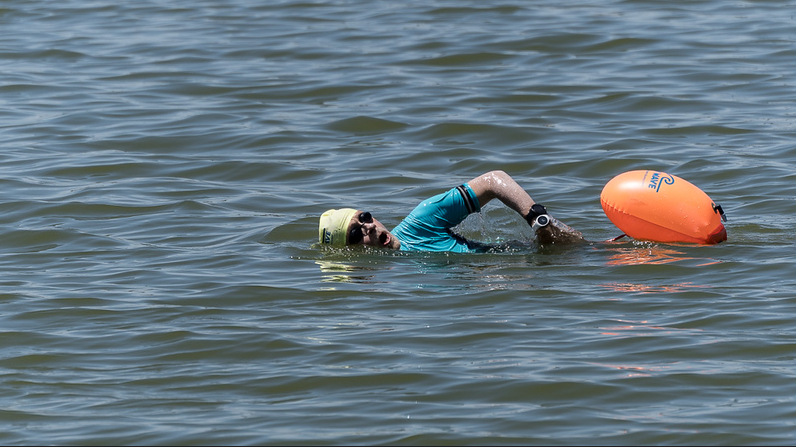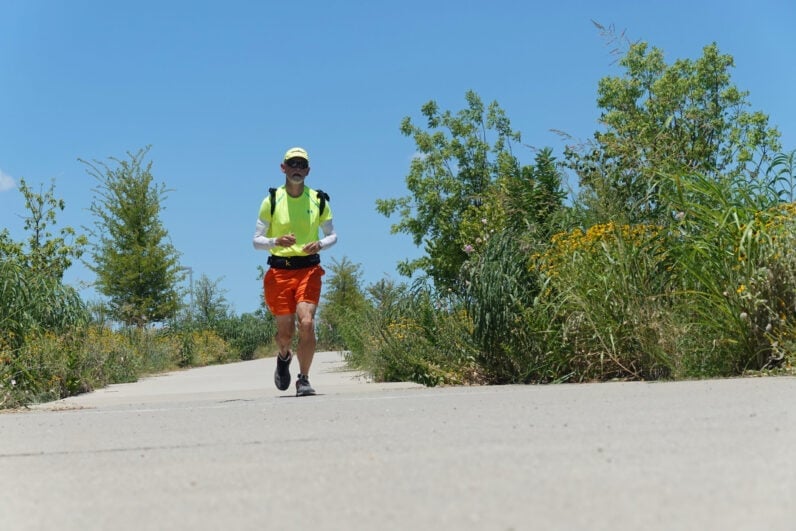Your donations help T1Determined #keepgoing.
2024 T1DecaMan Solo 10X Iron Triathlon Challenge
GOAL: to be the first Type 1 diabetic athlete to complete a 10X Ironman—the T1Decaman
Monday, September 16, through Tuesday, October 8th 2024
My plan is to complete the 24 mile swim, 1120 mile bike segment, and 262 mile run in 23 days.
I came close in 2023, until a kidney stone ended my attempt on Day 1 of the run segment and left me with anemia and a two-month recovery.
With luck, this year I'll get it done.
During this 23-day OYO ("on your own") solo challenge, I'll complete the equivalent of 10 consecutive full 140.6-mile Ironman triathlons. I'm balancing it with work, so I divided it up into chunks I can do in a day. The detailed schedule is at the bottom of this page.
1406 miles in 23 days is a physical, mental and spiritual challenge, and my path to this destination has been full of twists and turns.
In 1972 at age 10, I was diagnosed with Type 1 diabetes.
Back then, my doctor warned me against exercise because my blood sugar might go low. Glucose meters, CGMs and insulin pumps didn't exist yet, so I didn't have a reliable way to tell if my sugar was plummeting or spiking.
But that advice plus constantly overtreating lows with food left me 50 pounds overweight by 2003, and I faced a proliferative diabetic retinopathy diagnosis that left me with blind spots in my left eye.
I was terrified, but determined to stop that train in its tracks. I stumbled across a tiny number of amazing local T1Ds who gave me new ideas about balancing blood sugar, food and activity -- and that gave me enough confidence to keep going.
Twenty-plus years later, here I am.
My eyes are better, not worse—although my eye doc always has a preauthorized prescription for Lucentis or Avastin ready to go.
It's been seven years since I had a post-exercise low that required glucagon and I've gotten better and better at avoiding or at least moderating post-exercise highs.
Still going, always #t1determined.

This September I'll attempt 24 mi swimming, 1120 mi cycling, and 262 mi running in 23 days.
I take a rest day between each sport, and I don't do anything when thunder and lightning are present.

Swim - Daily Sept 16-18: COMPLETED!
Schedule: I swam 8 miles/day for 3 days, starting at 9:30 AM and finishing around 5:30 PM.
Location: Little Elm Sandy Beach at Lake Lewisville.
Each day's swim consisted of 8 1-mile loops of the outer buoy line.
Rest Day - Sept 19

Bike - Daily Sept 20 - 29 - "10 Days of Texas": COMPLETED!
Schedule: I ride two 56-mile loops/day for 10 days, totaling 112 miles/day. The route is ~80% paved paths and 20% quiet roads.
I start at 6:30 AM before first light. Sunrise is around 7. I finish around 7 PM, before sunset. I stop for fuel, hydration and/or restroom breaks about every 20 miles or so.
Route: Each loop runs Plano to Richardson to Far North Dallas, White Rock Lake and Deep Ellum, via Bluebonnet Trail, Chisholm Trail, downtown Plano, Central Trail, Greenville/Avenue K bike lanes, TI Blvd, Cottonwood Trail, White Rock Creek Trail, SoPac Trail and Santa Fe Trail.
Company welcome. RSVP through the website Contact Form or via DM on Facebook.
Rest Day - September 30

Run - Daily October 1-8: COMPLETED!
Schedule: I'll start at 7 AM daily and finish around 7 PM, for 8 days.
Route: It's a relatively flat 33-mile point-to-point loop through Plano, Garland, and Richardson, then back to Plano, on paved multi-use paths with regular water and restroom stops.
Company welcome. RSVP through the website Contact Form or via DM on Facebook.
Where's Don Right Now?
Live updates on my position, uploaded in real time from my Garmin InReach.
Feel free to stop and say hi if you're in my vicinity - it makes my day!